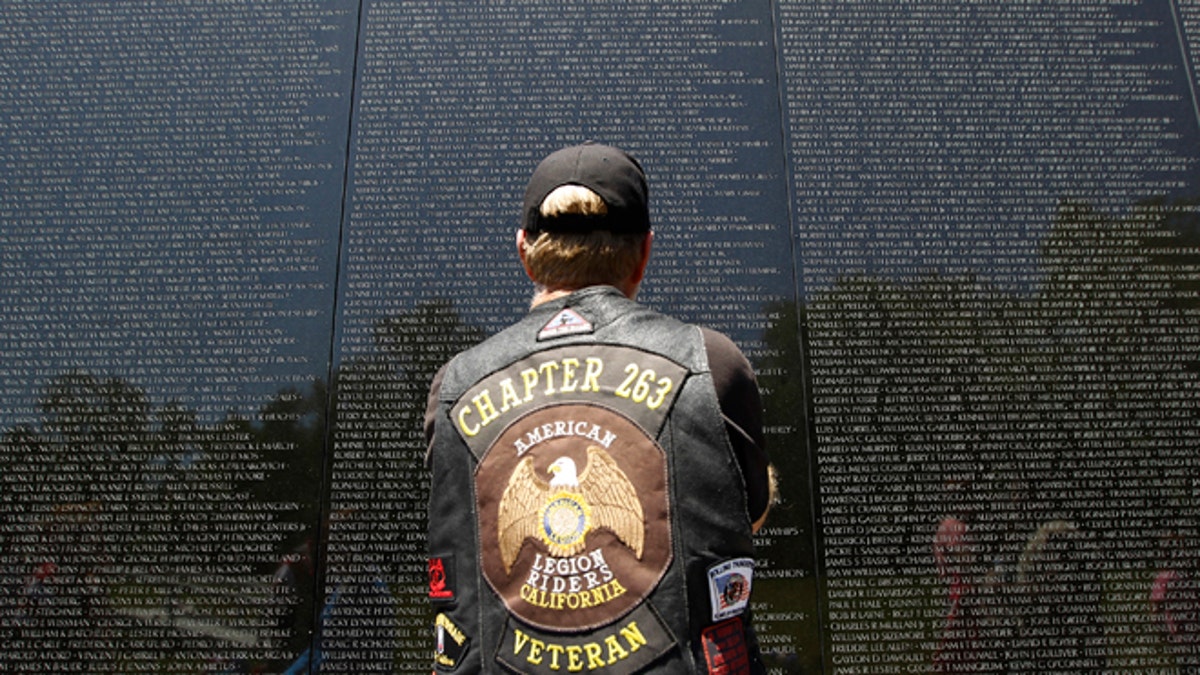
May 26, 2013: A veteran looks at the names of those who died etched into the wall of the Vietnam Veterans Memorial, ahead of Memorial Day in Washington, Sunday. (AP)
Jan C. Scruggs volunteered to go to Vietnam just after graduating high school. As a young 19-year old infantryman, he served with the 199th Light Infantry Brigade of the U.S. Army. He was wounded and witnessed the aftermath of a mortar accident that left 12 people dead, an event that profoundly impacted him. When Scruggs left Vietnam, he figured he’d left the war and Vietnam behind.
After the war, he came home and studied psychology at American University. His experience led him to examine the effects of war on the psyche. Ironically, he credits his wounds with his ability to attend college, where he earned both a bachelor’s and master’s degrees. He researched post-traumatic stress disorder — a condition he believes he probably had.
He has said that the creation of the Wall grew more out of his study of psychology, healing, and PTSD than of any incident in the war. All of this came from the work he did in graduate school where he became an authority on post-traumatic stress disorder. He published a number of articles and even testified before the Senate.
So the theory behind this memorial was that the individuals—veterans, their families, and people who had difficulties stemming from the war—would have a place to go to make peace with a tragic event from the past.
More from OpsLens.com
In 1979, Scruggs conceived the idea of building the Vietnam Veterans Memorial in Washington, D.C., as a tribute to all who served during one of the longest wars in American history. He felt a memorial would serve as a healing device for a different kind of wound—that inflicted on our national psyche by the long and controversial conflict.
He asked his boss at the Department of Labor for a week off to hatch his project and start planning what would become one of the most recognizable monuments in the country. He recalled his boss giving him permission, saying, “Everyone needs a mental health day.”
Soon, Scruggs quit his job to focus full time on the memorial, and he and his wife lived on her salary from an administrative job with Paralyzed Veterans of America. It had only been four years since the last troops left Vietnam, and the nation was in no mood to discuss a war that had torn it apart.
AIR FORCE HONOR GUARD RESPECTS THOSE WHO MADE THE ULTIMATE SACRIFICE
“The country was going to forget the Vietnam War, there’s no doubt about that,” Scruggs said. “It was a bad memory for the nation in many ways.”
As the nation wrestled with the war’s aftermath, Scruggs became the head of a team of young, impassioned veterans and their allies who got legislation and $8.4 million in funding to build the memorial. The Wall was more of a calling, “It needed to be done,” he said.
To find a design for the memorial, in 1981 he launched what he says was the largest architectural competition in history. More than 1,400 submissions poured into the anonymous panel of judges. When the time came to display the entries, Scruggs had to rent a hangar at Andrews Air Force Base in Maryland. The winning submission was from 21-year-old Yale undergrad Maya Ying Lin. Her design was simple and unconventional — a black wall engraved with the names of more than 58,000 Americans killed in the war.
BATTLE OF MIDWAY DIVE BOMBER PILOT: 'NEVER CALL ME A HERO'
In 1982, a black granite memorial with more than 58,000 names stretched over 70 panels took its place among the landmarks of Washington, D.C. It reminded all who visited that, as the inscription puts it, “Our nation honors the courage, sacrifice, and devotion to duty and country of its Vietnam veterans.”
The message and the design borne from criteria that specifically forbade political statements was simple: These are the service members, the sons and daughters, the old and (mostly) young, who have given everything for the nation’s greater good.
Jan Scruggs had a dream, and from day one of the unveiling of the Vietnam Veterans Memorial, a nation long tormented by an unpopular war began a miraculous process of remembrance, healing, and honoring those who served and died.

